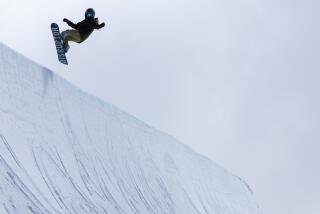Downhill Conditioning
- Share via
The ideal month to begin downhill ski conditioning is October, not now, with the first ski trip for many travelers just weeks or days away.
But don’t panic. Travelers who haven’t worked out can still squeeze in some last-minute preparation to minimize injury risk and build endurance, experts say. Those who have stayed in reasonable shape all year can now focus on fine-tuning their conditioning.
For procrastinators heading for a downhill ski trip, a daily stretching routine--even one begun now--is an excellent idea, said Dr. Thomas P. Knapp, orthopedic surgeon at St. John’s Hospital and Health Center in Santa Monica and USC clinical instructor of orthopedic surgery. Twice a day, for just five or 10 minutes, sit on the floor and stretch, he said. Pay particular attention to arms, legs and back.
Follow this with an aerobic workout of some kind. “If you have access to a stationery bike, ride every other day to nearly the point of fatigue,” Knapp advised. “That will probably be seven or 10 minutes if you are out of shape.” The point is to strengthen the quadriceps, the large muscles on the front of the upper leg. “The quadriceps are the key to downhill skiing,” said Knapp, a veteran skier. This muscle is also the key to healthy knees, he added. “The quadriceps are the quickest in the body to atrophy and the most difficult to rehabilitate.”
Downhill skiers who have kept up their fitness regimens can follow the same stretching and bike routine, Knapp said, but their riding goal should be 20 to 30 minutes or longer. “If you can ride a stationary bike at level seven out of 10 for about 45 minutes three times a week, you will be able to ski without stopping all day,” Knapp tells patients.
If travelers have no access to stationary bikes, Knapp recommends “wall sits,” in which exercisers back up against a wall and then lower themselves as if sitting in a chair, holding the position until their muscles are fatigued.
Another option is to join a ski conditioning class. The ski preparation class offered at the Los Angeles Athletic Club, for example, began in October but runs through the whole ski season, until March or April. It meets for 45 minutes, twice a week, and members can drop in at any point in the season.
“We concentrate on muscle conditioning exercises, particularly for the lower body,” said Cathy Holly, Athletic Club aerobics/yoga/fitness supervisor, who has taught the class. Participants also focus on propulsive movements such as those used in downhill skiing. They also work out on the slide, a piece of equipment used in aerobics classes to build up muscles on the outer thighs.
If a health club or YMCA has no formal ski conditioning class, asking the trainer on duty which machines will best serve conditioning needs is advised.
At home, those bound for skiing can walk up and down stairs (if they are free of knee problems) and do basic squat exercises to further condition muscles, Holly said.
To improve balance, some experts recommend standing on one foot and then another.
When skiers are in reasonable shape, they can turn to instructional videos such as “Fundamentals of Downhill Skiing,” a 60-minute training guide ($29.95), or “Skiing With Jean-Claude Killy,” a 60-minute video with four audio tapes and a training guide ($49.95). Both are available from SyberVision Systems, Inc. ([800] 678-0887).
Once at the ski resort, altitude sickness is usually not a problem at elevations under 7,000 feet, but travelers should be alert to symptoms. Initially, skiers can experience headache, dizziness, fatigue, nausea and vomiting. Immediate descent is advised and medical help is indicated if symptoms persist.
On the slopes, Holly tells skiers to do a few nice, easy stretches and lunges. Stretching after skiing is also crucial to keeping muscles in good condition.
If you get a sprain or strain on the slopes, follow the traditional RICE advice used for injuries: rest, ice the injury, apply compression and elevate the injured part, Knapp said.
Those hurt so badly that they can’t get up or are afraid they are seriously injured should wait for the ski patrol.
If the injury involves ankles, shoulders or knees and is not life-threatening, “the preferred treatment would be immobilization and follow-up with your private doctor when your return home,” Knapp said.
But to avoid injury, recognizing one’s limitations is as important as conditioning. “About 75% of injuries occur at 3 or 4 in the afternoon, when people are fatigued,” Knapp said. Perhaps the most simple injury-reduction strategy--quit early--is often the most difficult to follow.
The Healthy Traveler appears the second and fourth week of every month.
More to Read
Sign up for The Wild
We’ll help you find the best places to hike, bike and run, as well as the perfect silent spots for meditation and yoga.
You may occasionally receive promotional content from the Los Angeles Times.






